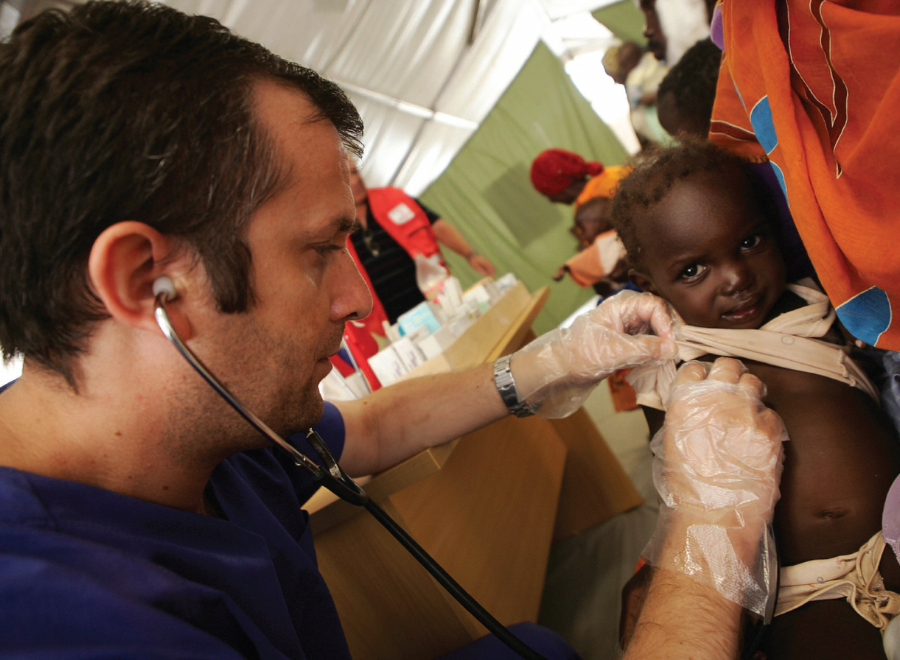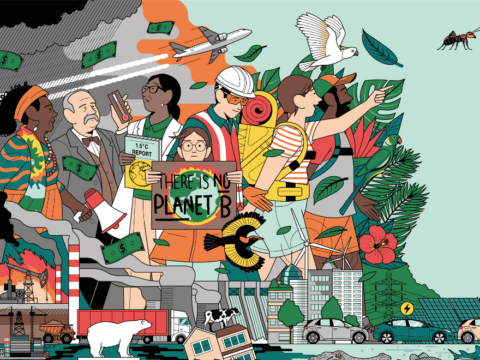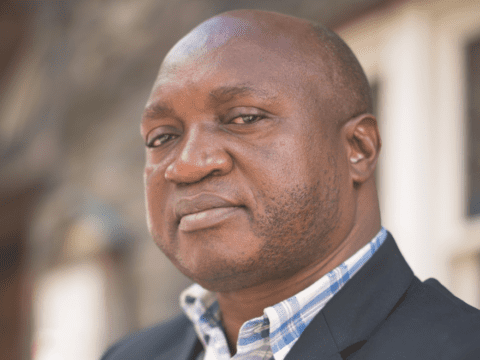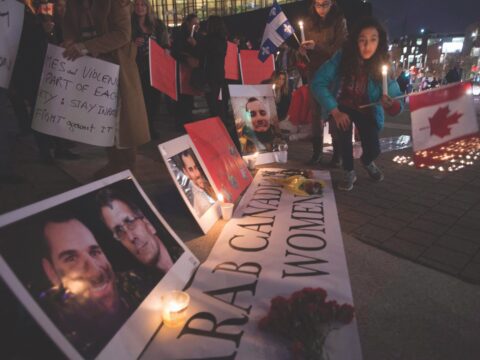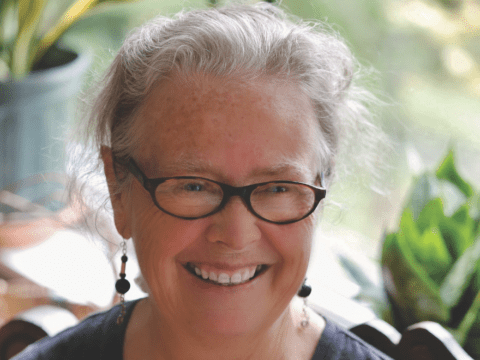For 16 hours, bombs dropped on and around the only hospital still standing along Sri Lanka’s northeastern coast. The Sri Lankan military had cornered the separatist Tamil Tigers and were determined to end a quarter-century-long civil war. As the shelling continued, more than 1,000 civilians — some severely injured — cowered in the hospital awaiting treatment. Overwhelmed doctors handed out gauze and bandages, and left dead bodies unattended.
When the aerial bombardment had finished, more than 50 people were dead, including patients, their relatives and at least one health worker. Bombs also killed Red Cross employee Mayuran Sivagurunathan and his mother, who were in the area to assist with the relief effort. A Red Cross ferry, stationed just off the coast, might have delivered food aid and evacuated the wounded. But the bombs put an end to that idea, too. As one Red Cross employee expressed at the time, it was an “unimaginable humanitarian catastrophe.”
As global emergencies mount at head-spinning speed, aid groups are increasingly caught in the crossfire. Last year was the most dangerous on record for aid workers, and 2009 isn’t looking much better. According to the Overseas Development Institute, a British think tank on international humanitarian issues, 260 humanitarian aid workers were killed, seriously injured and kidnapped in 2008 — the highest toll this past decade. Hotspots include Sudan, Afghanistan and Iraq. The number of deaths among aid workers even exceeded that of UN peacekeepers. The reasons for the increase are as varied and complicated as the situations themselves, but it would seem that humanitarian aid just isn’t sacrosanct any more. As a result, relief organizations, some faith-based, are rethinking how they deliver aid.
“There’s always a certain amount of danger and a dire risk of being caught in the wrong place at the wrong time,” says Bernard Barrett, spokesperson for the International Committee of the Red Cross. “But in recent years, we’ve seen a sharp increase in the numbers of casualties among our ranks. We continue to emphasize our neutrality. We do not make public pronouncements, pointing the finger at one side or the other. And yet, we’re facing more and more of these hostilities.”
Theoretically, the Geneva Conventions shield aid workers from harm. Enshrined 150 years ago to protect the sick, wounded and shipwrecked during wartime, the document evolved in 1949 and again in 1977 to guarantee the protection of humanitarian workers in conflicts. These protections include the right of aid workers to be treated humanely, to be free from violence to life and person, hostage taking, humiliating or degrading treatment, and imprisonment. But events of the last 12 months suggest mounting disregard for the Conventions — and the lives and efforts of aid workers. The escalating violence has forced many aid organizations to relocate or suspend their operations altogether.
One of the biggest dangers facing aid workers is the perception that they’re taking sides. Kevin McCort, CARE Canada’s president and CEO, says, “Assaults on aid workers aren’t exactly random; it’s not about workers being caught up in a given circumstance Despite of our best efforts to…keep our aid impartial and out of power struggles, sometimes warring parties go ahead and define our work by their own politics.”
He continues: “More and more, there’s a willingness by fighting forces to expand their tactics to aid workers. We’re no longer seen as external to the fight. Often times, the best way to take over a piece of land is to drive people out of it, and so, anyone delivering humanitarian assistance and enabling people to stay put is merely obstructing that objective, in some perspectives.”
The Red Cross’s Bernard Barrett says neutrality has long been his organization’s core principle, yet its historical red and white emblem — emblazoned on all T-shirts, tent canopies and vehicles — is too often disregarded. “We invest a lot of time with all the different groups involved in a conflict, whether they be government sources, community organizations, armed forces or even those who may be considered terrorists. We always remind folks of who we are and what we’re doing in order to get security guarantees….But when you’re looking at a given conflict, you’re looking at a situation in which emotions and opinions become polarized. There are always going to be suspicions as to why we’re helping the other guy, and why we’re giving medicine and food to civilians on the other side. It’s frustrating.”
Wariness on the part of some governments also puts aid workers at risk. Gary Kenny, The United Church of Canada’s program co-ordinator for Southern Africa and emergency response, says, “Zimbabwe, especially, has been very suspicious of any western intervention or involvement. There’s a conception that NGO members are all spies, trying to undermine African sovereignty. So they watch local aid organizations — those connected to western countries — very carefully. They expel them if they deem it necessary. This is driven not only by one-dimensional or superficial military agendas; it’s born out of post-colonial thinking and an utter sense of desperation. Naturally, [the hostility] in some African countries runs pretty deep.”
Some militaries, including Canada’s, have taken up humanitarian action. On the surface, it’s a laudable effort, but it’s putting aid workers in jeopardy. For example, in Iraq, U.S. soldiers dressed in T-shirts and concealed their weapons in order to distribute food and equipment to local populations. Aid groups say it was a blatant effort to manipulate Iraqi hearts and minds. Exasperating relief workers further, the former U.S. administration went as far as dubbing American NGOs “force multipliers” for the coalition army — a description that made humanitarian aid appear to be an instrument of military policy.
In a recent letter to Prime Minister Stephen Harper, the Mennonite Central Committee said, “Canada should discontinue the practice of engaging military personnel in development and reconstruction work” in Afghanistan because it “politicizes the delivery of aid, and endangers both aid workers and civilian recipients of aid.”
John Nduna, the director of Action by Churches Together International, agrees. The co-opting of humanitarian aid “has undermined the ability of ours and other humanitarian organizations to address the critical needs of civilian populations,” he says. ACT is the agency through which the United Church does most of its relief work worldwide. In Iraq, it has assisted many of the country’s 2.8 million displaced persons, distributed food and hygiene items to thousands of families, and built 25 shelters for vulnerable families. “When humanitarian action is used for political or military ends, it only further blurs the lines between military personnel and relief workers. Insurgent groups wanting to strike back at military targets will then strike back at anyone western-looking. And it’s easier to target an international aid agency; we’re the ones without guns and bombs.”
In light of the increasing risks to relief workers, aid agencies have embarked on a period of self-reflection.
There’s no panacea. The situations are as wide-ranging as they are complex. However, one of the solutions, says Nduna, is for the aid sector to come up with new security guidelines and policies for workers. “We’ve had to shift our thinking dramatically in how we prepare our members, so that they can operate safely in hostile environments and continuously provide the assistance that’s so desperately needed. Also, we now exchange information about threats and risks with other organizations more than we ever did before.”
While poverty and a lack of opportunity is a problem in war-torn regions, anti-western sentiment remains a major obstacle. The United Church’s Gary Kenny says good public relations are essential. “You can make some inroads into countries by creating a different impression of the value and need of humanitarian aid. An exceedingly important goal is the employment of local populations at the grassroots level — the basis on which the United Church works. We’re more interested in strengthening the capacity of the people and organizations with which we’re in partnership instead of deploying expatriate personnel.”
Around the world, 96 percent of CARE International’s staff members are from the countries where they work. “It’s about working with local governments, community leaders and religious leaders and being as transparent and accountable as we can,” says McCort. “It’s incumbent on us to demonstrate that we’re not in any country to push an agenda other than ending global poverty.”
Small-time banditry is both a fact of life in many developing countries and a threat that needs to be addressed. Aid groups are taking extra measures to protect themselves: using padlocked gates and surveillance cameras, as well as security staff. Mark Simmons, director of Fellowship for African Relief in Sudan, says showing up in bulletproof jackets and helmets would only build distance between workers and local populations. For the most part, organizations such as his are adopting an “invisible” approach, keeping a low profile as they support the work of local partners.
With guarded optimism, foreign aid agencies have quietly redeployed expatriate workers to Iraq following a drop in violence in the country to four-year lows. In an effort to stop military forces from co-opting humanitarian aid, many non-governmental organizations are strongly reinforcing their independence by moving their operations away from political and military ones — even toward more rural areas, where they can serve more vulnerable populations in relative peace.
Gone are the days when the neutrality of international aid organizations was widely recognized. But Barrett urges all those who support international aid agencies to keep hoping and to focus on their successes. “In spite of the hijackings and killings of the agencies’ workers, even as the world is pushed to the tipping point, we remain operational,” he says.
“We can’t naively think that we’re going to be able to do everything for everyone. We just have to constantly remind ourselves what our specific role is — what we can realistically accomplish. And when in doubt of a particular situation, we have to remember to say ‘no’ rather than put ourselves — and, of course, the long-term mission of our organizations — in danger.”
***
This story first appeared in The United Church Observer’s July/August 2009 issue with the title “Aid under fire.”

